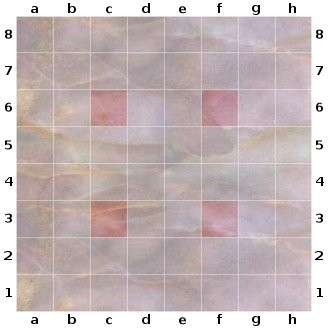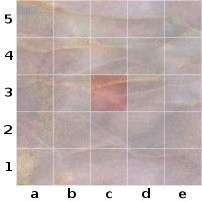Arimaa/Advanced Tactics
< ArimaaIn the majority of Arimaa positions, the side to move will not be able to directly force a goal or capture. Nevertheless, Arimaa is a highly tactical game. If both players are armed with a knowledge of basic strategy, then advantage accrues to the player who can execute better on those ideas. Knowing that an elephant blockade, camel hostage, or horse frame is strategically valuable is only half the battle: one must also know how to bring about such advantages against intelligent opposition.

| |||||||||||||||||||||||||||||||||||||||||||||||||||||||||||||||||||||||||
| Silver threatens to capture the g5 gold horse (game) | |||||||||||||||||||||||||||||||||||||||||||||||||||||||||||||||||||||||||
False protection
In the position shown here, no pieces have yet been exchanged, but Gold is apparently in great trouble. The gold horse on g5 is threatened with capture in f6. The g3-dog could unfreeze the threatened horse, but this would only allow it to advance further into danger.
The gold elephant could, in two steps, occupy e6, which would make f6 safe from capture, but then the gold camel would be threatened in c6. The gold camel is frozen, and it needs three steps to retreat. Either the b4 rabbit can advance, allowing the camel to push back to c4, or the d4 cat can push away the c4 rabbit, allowing the camel to step to b5. Unfortunately, neither of these camel-rescue maneuvers leaves the requisite two steps for the gold elephant to protect f6.
The gold elephant could temporarily protect both c6 and f6 by pushing the silver dog on e6 into f6, and then return to d6 with a step to spare. However, that would waste three steps doing what could be undone by Silver in one step, allowing him three steps to consolidate/improve his position. One can prove that this delaying move does no good for Gold by analyzing in detail each of his possible fourth steps, and considering of Silver's replies. In a live game with limited time, however, it is best to assume that trading three steps for one step will make one's position worse. That assumption would be borne out in this case.
It remains to consider charging forward with the camel to set up a threat to balance Silver's threat. Gold could advance the b4 rabbit, then advance the camel and push away the silver cat on c7. Silver then couldn't take the g5 horse without losing the b6 horse and allowing a thunderous attack in the west. This attack by Gold looks promising, but it opens a fatal weakness. Silver could simply slide his elephant to c5 and advance his newly-liberated c4 rabbit to b2, through the now unoccupied b4. Gold would then be unable to save goal, his camel, and his horse all at once.
In short, it appears that no move will stave off material loss for Gold, and some attempts to do so will only make matters worse. It seems that capturing the c4 rabbit in exchange for the g5 horse is the best Gold can do.
Remarkably, Gold has a tactical save that relies on the elephant to protect neither c6 nor f6. Gold can advance his elephant to d7, capture the c4 rabbit with his cat, and slide the unfrozen camel to b5. This exposes a subtle weakness in the Silver position: the false protection of the b6 horse and c7 cat. If Silver were to then capture the threatened gold horse in f6, Gold could respond by capturing the b6 horse in c6.
The difference between finding this tactic and missing it is an entire horse. Instead of losing a horse for a rabbit, Gold has gotten a rabbit for free.

| |||||||||||||||||||||||||||||||||||||||||||||||||||||||||||||||||||||||||
| Silver to move can blockade the gold elephant (game) | |||||||||||||||||||||||||||||||||||||||||||||||||||||||||||||||||||||||||
Elephant blockade
In the position at left, the gold elephant is in great danger of blockade on the seventh rank. Silver to move can't prevent the gold elephant from moving away from e7, but most of the walls of a larger box are already in place. If Silver can cut off all avenues of retreat, then the noose can be drawn tight around the gold elephant in later moves.
One brick in the wall is the f6 trap square. With no supporting gold pieces, the gold elephant can't pass through f6. The e6 square can be sealed in two steps by the silver elephant. The g6 square is blocked by the phalanx of four silver pieces on f6, g6, h6, and g5. A second phalanx (d8, d7, d6, c7) can block access to d7 if Silver uses one step to put his c6 rabbit onto d6. Therefore, with a total of three steps (elephant to e6 and rabbit to d6), Silver can create a nearly complete box.
The tricky tactical issue is the use of Silver's fourth step. If Silver attempts a blockade, Gold retains two resources: the gold elephant can still threaten an end-around to push out through h6, and the gold horse on g3 can pull the g5 dog out of the blockade. In combination these threats pose a serious puzzle for Silver to solve, but they are not necessarily enough.
For example, if the gold elephant moved directly to h7, Silver could slide his dog to h5, horse to g7, f8 rabbit to g8, and f6 cat to f7. True, the gold horse could then pull away the silver dog from h5, but Silver could re-establish the blockade with camel to h5 and elephant to g6. Such a perfect blockade is easily worth a dog sacrifice.
It is tempting for Silver to use the fourth step to advance his f8 rabbit to f7. We know already that the gold elephant can't simply push across to h7. But consider what happens if instead Gold pushes the rabbit back to f8, stations his elephant on g7, and advances his horse to g4. Gold now threatens to pull the dog and push the camel, creating a path to freedom. Silver has many ingenious attempts to maintain the blockade, but none of them quite work. For example, Silver might try putting his dog on h5 and using the camel to pull the horse to g5, so the gold horse actually becomes part of the blockade! This fails, however, as the Gold elephant can move to h7, pulling the silver camel along to g7, then push the h6 rabbit to g6 as the elephant escapes through the h-file.
It turns out that preventing this latter maneuver is precisely the key to sealing the blockade. If Silver uses the fourth step to advance a rabbit to h7 (instead of f7), Gold cannot escape unscathed. Gold's previous escape plan now only has three useful steps: elephant to g7 and horse to g4. Let's suppose rabbit to g2 is the fourth step, in order to unfreeze the gold horse in some lines. (to be continued...)
Repetition fights
The rules of Arimaa state that it is illegal to play a move resulting in a position appearing for the third time with the same side to move. A sequence in a game where repetitions are possible, and so this rule is relevant, is called a repetition fight. Much the most common type of repetition fight is a cycle: from an initial position, there is a sequence of moves resulting in that position appearing for a second time, with all intermediate positions being distinct.
Suppose Gold is to play in a position P, and that later Silver plays a move resulting in P appearing again. If both players continue to play the same way, the second iteration of the cycle cannot be completed: Silver's final move of the cycle would cause P to appear for the third time, and so would be illegal. It is therefore Silver who must deviate, and Gold (who played first in the repetition fight) is said to win the fight.

| |||||||||||||||||||||||||||||||||
Pull and replace moves are a common source of one-move (two-ply) cycles. In this diagram, Silver can break the horse frame by playing a pull and replace with her camel, moving the gold horse to b4 and the silver horse to b3. This move is reversible: Gold can undo it by using his elephant to play a pull and replace. However, Silver has played the first move in a cycle, and Gold can only undo Silver's move once.

| |||||||||||||||||||||||||||||||||||||||||||||||||||||||||||||||||||||||||
| An unusual pull and replace sequence, from this game | |||||||||||||||||||||||||||||||||||||||||||||||||||||||||||||||||||||||||
In this game a fight is ongoing over whose horse will be able to occupy g3. A sequence of four pull and replace moves is possible. Silver plays mh4w mg4e Hg3n hh3w (gold horse to g4, silver horse to g3). Gold then establishes a frame with Ef4s Ef3n hg3w Hg4s (silver horse to f3, gold horse to g3). Silver breaks the frame with mh4s mh3n Hg3e hf3e (gold horse to h3, silver horse to g3). Gold can then regain trap control with Ef4e Eg4w hg3n Hh3w (silver horse to g4, gold horse to g3). Although each of these moves other than the first can be undone, each move reaches a new position, so the individual repetition fights do not change the outcome: it is Silver who is forced to play a move other than a pull and replace.